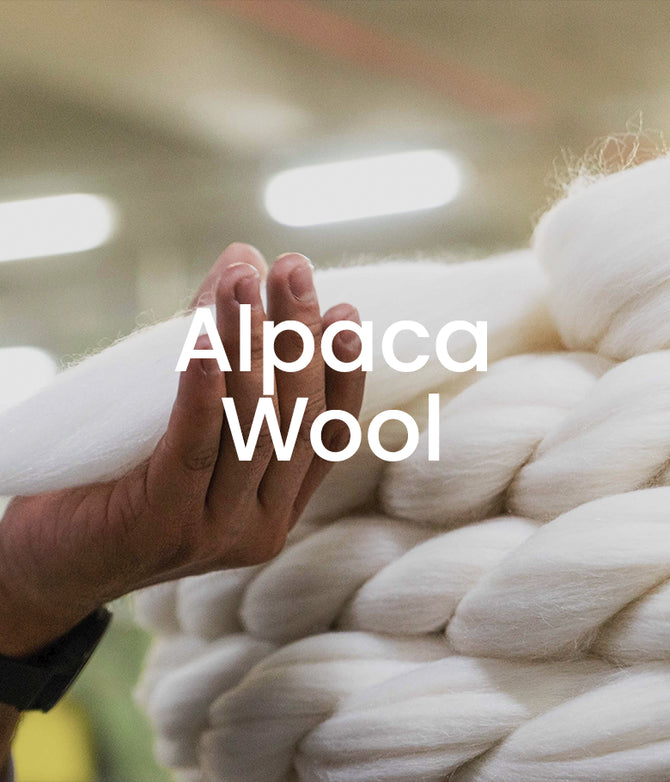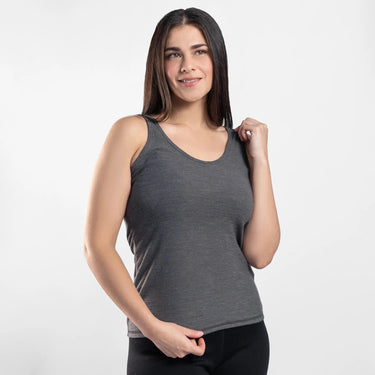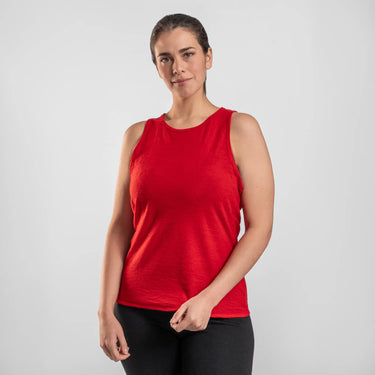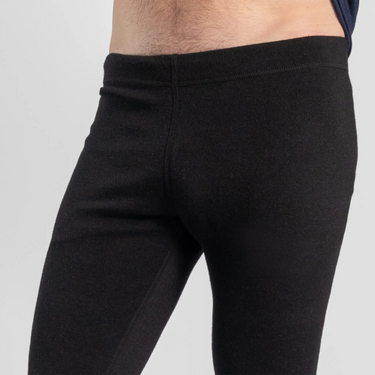WHAT MAKES ALPACA WOOL BEST FOR HIKING?
Published Feb 18. 2019 | Updated Dec 3, 2024
Reading time: 4 minutes
Alpaca wool hiking gear is a somewhat new concept in an outdoor industry accustomed to synthetics and merino wool. However, a closer look reveals that alpaca wool has unique qualities that make it the best choice for hiking clothes.
Its versatility allows you to wear alpaca hiking apparel year-round and across a range of activities. Alpaca base layers and thermal leggings work well for winter sports, while in spring and autumn, they can be worn as standalone pieces. Additionally, alpaca shirts, jackets, sweatpants, and accessories are reliable staples for outdoor adventures, camping, and travel in any season.

Technical Properties of Alpaca Wool
Alpaca wool may be well-known in the fashion world, but it also has technical qualities similar to merino, making it ideal for hiking and other outdoor activities. Here’s why:
WARMTH
Alpaca wool has natural air pockets within each fiber, which trap even more air within the knit [1] due to the fiber’s wavy texture. Your body heats these tiny pockets, providing added warmth. This makes our mid layer fleece jackets and hoodies perfect for cold conditions.
MOISTURE-WICKING & BREATHABILITY
Alpaca wool resists absorbing water—whether it’s sweat or light rain—and instead wicks moisture away from your body [2,3]. This makes alpaca clothing exceptionally breathable and comfortable [2], keeping you drier when you sweat and cooler in warm weather. Our all-season base layers are perfect for spring and autumn hiking and as a close-to-skin layer in winter, as well as cool summer evenings at camp.
LIGHTWEIGHT
Since alpaca wool fibers are partially hollow—or “semi-medullated” in scientific terms, they are significantly lighter than other woolen fabrics [4]. With our variety of fabric weights from 110gsm to 420gsm, you can tailor the weight and bulk of your hiking gear to your needs.
ODOR RESISTANCE
Sweat causes odor when bacteria break down particles in it, creating an unpleasant smell. Because alpaca wool is highly breathable and naturally antimicrobial, it prevents bacteria growth, keeping you odor-free even after intense hikes [3]. With alpaca wool socks, you can forget about stinky feet after a tough trail.
WIND RESISTANCE
Like sheep’s wool, alpaca is not very permeable to air [4]. Further, our thicker fabrics are tightly knit, allowing alpaca wool garments to act as wind barriers. Unless you expect heavy rain or extreme winds, you won’t need an additional windproof jacket.
SUN PROTECTION
Alpacas, adapted to the high solar radiation in the Peruvian Andes, produce wool that offers natural sun protection [5]. Our alpaca wool neck gaiters and long sleeve shirts provide natural coverage without causing overheating.
FLAME RETARDANT
Due to its chemical composition and microscopic structure, alpaca wool doesn’t ignite easily, doesn’t sustain flames [6,7], and unlike synthetics, doesn’t melt when exposed to heat. These are crucial features when you’re cooking on a camp stove or around a fire in the backcountry.
STAIN RESISTANCE
Because alpaca wool doesn’t absorb water easily it resists stains carried in water. This is a fantastic feature for backpackers on extended trips with just one pair of alpaca wool thermal leggings.
At Arms of Andes we use the finest Royal Alpaca Wool sourced in the Peruvian Andes. The Andean alpacas naturally developed over thousands of years in harsh conditions in high altitudes, creating the perfect fiber for outdoor gear that helps you stay protected in all conditions.
Discover our outdoor apparel.

Is Alpaca Wool Only for Winter?
If your only experience with wool is a Christmas sweater or the thick alpaca wool sweaters and hats commonly seen on the high street, you might think alpaca wool clothing is only for winter and snowy settings. In reality, the unique properties of royal alpaca wool, particularly its lightness and breathability, make it ideal for spring and summer hiking as well. Our heavier alpaca wool fabrics are great for winter sports and travel, while combining different products in various layering configurations gives you versatility across all seasons and activities. Here’s how your alpaca wool wardrobe can work for you year-round:

SPRING & FALL
Spring can bring mixed weather—some days are warm, while others still carry the chill of winter. Snow may linger, and rain can bring temperatures down. Hiking in spring and fall requires gear that’s adaptable for varying conditions. Our lightweight alpaca wool leggings make the perfect base layer and can be worn under rain pants or on their own. If you prefer something looser, our alpaca wool joggers offer a comfortable fit.
For the upper body, pairing an alpaca wool base layer with an alpaca shirt provides flexibility as temperatures and activity levels change throughout the day. Bringing a wool mid-layer for extra warmth during chilly evenings or in early spring/late autumn in colder regions.
At Arms of Andes we make our gear from 100% Royal Alpaca Wool of 18-18.5 microns.
T-SHIRTMIDWEIGHT HOODIE
SUMMER
Summer is where our alpaca wool shirts shine. Our ultra-lightweight 110 fabric is breathable, so won’t feel stifling even in the heat. Use our long-sleeve shirts for sun protection, while our short sleeve t-shirts work perfectly for hot day hikes or beach outings. Wool underwear is an excellent option for summer hiking since alpaca wool wicks sweat away, helping you feel cooler. For cooler summer evenings, a lightweight alpaca wool base layer is a great addition to your pack for camping during backpacking trips, or enjoying those long daylight hours.

WINTER
Winter hiking and snowshoeing are all about layering, and alpaca wool gear excels here. Depending on the activity, you may only need wool thermals under waterproof ski pants, but for winter camping or extremely cold conditions, pairing leggings with alpaca wool joggers will keep you extra warm. For the upper body, you can layer shirts, base layers and mid-layers, in a way that suits the weather, your activity level, and personal comfort. Our alpaca wool beanie stays secure under a hood or helmet, and our neck gaiters double as face coverings, headbands, or scarves—without loose ends getting in the way!
Alpaca wool is lightweight, breathable, warm and odor-resistant, making it the perfect fiber for year-round use across a variety of activities like hiking, skiing or running.
Glossarykeywords
Breathability
The ability of a material to allow air circulation, ensuring comfort and freshness.
Flame Retardant
A property that makes a material resistant to ignition and the spread of flames.
Moisture-Wicking
A material property that allows moisture to move away from the body to the outer layer of the fabric, keeping the skin dry.
Odor Resistance
The ability of a material to prevent the growth of bacteria that cause unpleasant odors.
Stain Resistance
The ability of a fabric to repel stains and maintain a clean appearance.
Sun Protection
A feature of some materials that blocks ultraviolet (UV) rays, protecting the skin from sun exposure.
UV Radiation
Ultraviolet rays from the sun that can cause skin damage without adequate protection.
Wind Resistance
A material's ability to act as a barrier against wind, reducing the sensation of cold.
At Arms of Andes we use the finest Royal Alpaca Wool sourced in the Peruvian Andes. The Andean alpacas naturally developed over thousands of years in harsh conditions in high altitudes, creating the perfect fiber for outdoor gear that helps you stay protected in all conditions. Discover our outdoor apparel.

Alpaca wool (particularly the royal and baby alpaca fiber grades) is non-itchy, warm, and performs better than merino and other types of sheep's wool. This makes alpaca wool perfect for your outdoor clothing, slipper socks, and even underwear.

Alpaca wool (particularly the royal and baby alpaca fiber grades) is non-itchy, warm, and performs better than merino and other types of sheep's wool. This makes alpaca wool perfect for your outdoor clothing, slipper socks, and even underwear.

References:
[1] Atav, R., & Türkmen, F. (2015). Investigation of the dyeing characteristics of alpaca fibers (Huacaya and Suri) in comparison with wool. Textile Research Journal, 85(13), 1331-1339. https://doi.org/10.1177/0040517514563727
[2] Choudhury, A. K. R. (2023). Sustainable protein fibres. In Sustainable Fibres for Fashion and Textile Manufacturing (pp. 181-226). Woodhead Publishing. https://doi.org/10.1016/B978-0-12-824052-6.00010-X
[3] Acevedo Villazana, L., Mora Altez, C. S., & Camargo Hinostroza, S. (2022, April). Analysis of the vicugna pacos (Alpaca) wool fiber in the properties of concrete. In International Conference on Advances in Environment Research (pp. 129-139). Cham: Springer International Publishing. https://doi.org/10.1007/978-3-031-26365-1_11
[4] Ünal, P. G., Atav, R., Ilarslan, S., & Kastaci, B. B. (2019). The effect of using alpaca and silk instead of wool in weft yarns on the woollen fabric properties. Journal of Natural Fibers. https://doi.org/10.1080/15440478.2018.1448319
[5] Moore, K. E. (2015). The impact of fleece characteristics on insulation and heat exchange, and the consequential effect on vitamin D of alpacas in southern Australia.
[6] Czaplicki, Z. (2012). Properties and structure of polish alpaca wool. Fibres Text. East. Eur, 20, 8-12.
[7] Galaska, M. L., Sqrow, L. D., Wolf, J. D., & Morgan, A. B. (2019). Flammability characteristics of animal fibers: single breed wools, alpaca/wool, and llama/wool blends. Fibers, 7(1), 3. https://doi.org/10.3390/fib7010003






















